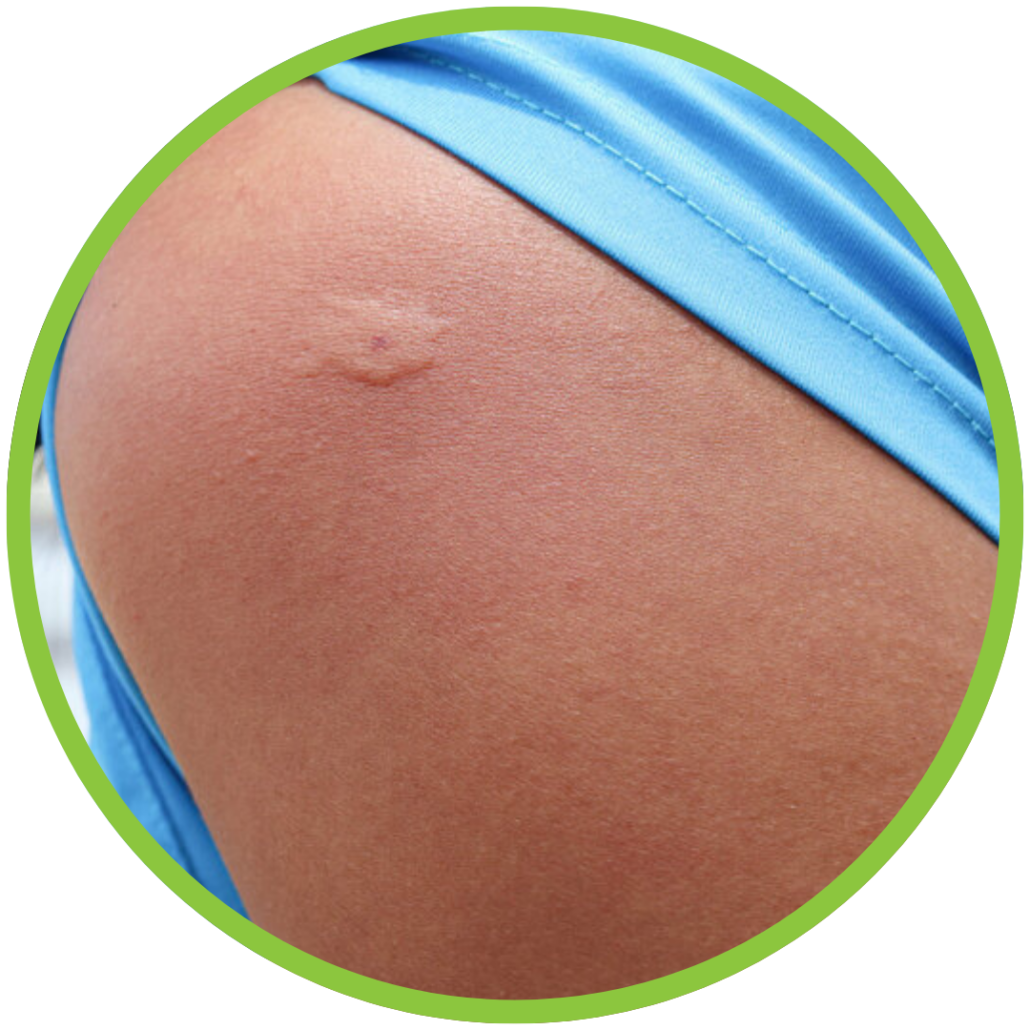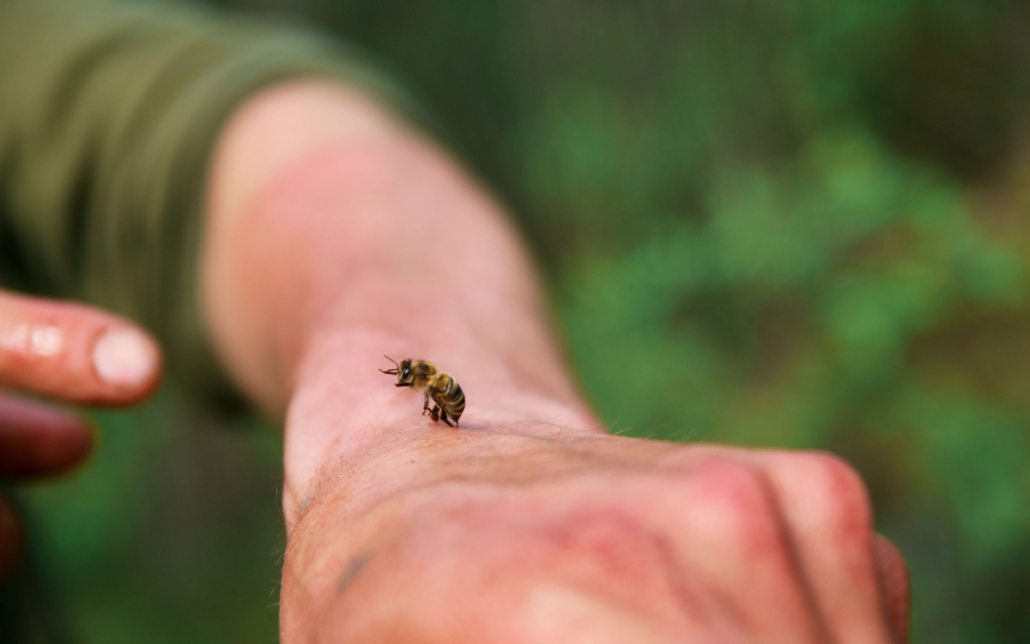Imagine enjoying a sunny afternoon in your garden, when suddenly, you feel a sharp sting. For most people, a bee sting is a momentarily painful inconvenience. However, for those who have a severe bee venom allergy, that small sting can be life-threatening.
Severe allergic reactions to bee venom, known as anaphylaxis, are medical emergencies that require immediate attention. This blog will shed light on the severity, symptoms, and management of these reactions so that you and your loved ones can be prepared for a potentially severe allergic reaction.
Understanding Bee Venom allergies
What is Bee Venom?
Bee venom is a complex mixture of proteins and peptides that is odorless and transparent.1 When a bee stings, it injects venom into the skin, which can cause pain and swelling at the site of the sting. The venom is designed to protect the bee and their hive from potential threats and predators. However, bee venom can affect humans in various ways, from a mild to a severe reaction called anaphylaxis.2
Types of Reactions to Bee Venom

Reactions to bee venom can range from mild to severe:
- Local reactions: These include pain, swelling, and redness at the site of the sting. This kind of reaction is common and typically resolves within a few hours or days.
- Mild systemic reactions: Symptoms such as itching, hives, and mild swelling may occur extending from the site of the sting. This kind of reaction may also cause general malaise, fever, or headache.2
- Severe systemic reactions: Also known as anaphylaxis, this is the most dangerous type of reaction and can be life-threatening. Symptoms can escalate rapidly and require immediate medical attention. If you or a loved one experience anaphylaxis, call 911 immediately.
Symptoms of Severe Reactions
Recognizing the symptoms of anaphylaxis is vital for timely treatment:
Immediate Symptoms
- Difficulty breathing
- Swelling of the throat and/or tongue
- Rapid pulse
- Dizziness or fainting
Delayed Symptoms
- Nausea and vomiting
- Diarrhea
- Stomach cramps
- Joint pain
Risk Factors for Severe Reactions
There are certain risk factors that can increase the risk of severe allergic reactions to bee venom:
- Previous reactions: Individuals who have previously experienced a reaction to a bee sting are at a higher risk of anaphylaxis with future stings. Luckily, this means that it’s less likely for children to experience extreme reactions upon their first sting.3
- Allergies and asthma: People with other allergies or asthma are more prone to severe reactions. The presence of these conditions can exacerbate symptoms and complicate treatment.
Diagnostics and Testing
Proper diagnosis and testing are essential for managing bee venom allergies effectively. Testing includes skin prick tests as a first step where small amounts of bee venom are introduced into the skin to observe reactions. If further testing is needed, an allergist may also conduct blood test that measure the level of IgE antibodies specific to bee venom in blood.

Importance of Medical Evaluation
Seeking a professional diagnosis is important for accurate identification and management. An allergist can develop a customized action plan that’s tailored to individual needs. You can use our find a provider tool to find an allergist in your area that treats bee sting allergies to start your treatment plan as soon as possible.
Treatment and Management
There are a few different options when it comes to treating and/or managing a severe bee sting allergic reaction. These combine both short-term and long-term strategies that you can discuss with your medical provider:
Immediate Treatment
- Epinephrine auto-injectors: These devices deliver a dose of epinephrine, which can rapidly counteract the symptoms of anaphylaxis.
- Emergency medical attention: Immediate medical help is critical when a severe reaction occurs, even if symptoms seem to improve after an emergency dose of epinephrine.
Long-Term Treatment
- Venom immunotherapy: This treatment involves regular injections of bee venom to build tolerance and reduce the severity of future reactions. 97% of patients show no systemic reaction 2.5 – 3.5 months into treatment while receiving the maintenance dose of venom immunotherapy.4
- Avoidance strategies: Minimizing exposure to bees through practical measures can help prevent a sting.
Severe reactions to bee venom are serious but manageable with the right knowledge and preparation. Understanding the symptoms, risk factors, and treatment options can keep you or your loved ones safe from experiencing a medical emergency. Stay informed, stay prepared, and spread awareness to help others navigate the challenges of bee venom allergies.
- Burzyńska, Marta, and Dorota Piasecka-Kwiatkowska. “A Review of Honeybee Venom Allergens and Allergenicity.” International Journal of Molecular Sciences, vol. 22, no. 16, 1 Jan. 2021, p. 8371, www.mdpi.com/1422-0067/22/16/8371/htm, https://doi.org/10.3390/ijms22168371.
- Wehbe, Rim, et al. “Bee Venom: Overview of Main Compounds and Bioactivities for Therapeutic Interests.” Molecules, vol. 24, no. 16, 19 Aug. 2019, www.ncbi.nlm.nih.gov/pmc/articles/PMC6720840/, https://doi.org/10.3390/molecules24162997.
- “Bee Stings | Boston Children’s Hospital.” Www.childrenshospital.org, www.childrenshospital.org/conditions/bee-stings#:~:text=Only%20about%201%20percent%20of. Accessed 30 July 2024.
- Venomil [package insert]. Spokane, WA: Jubilant HollisterStier Allergy.





